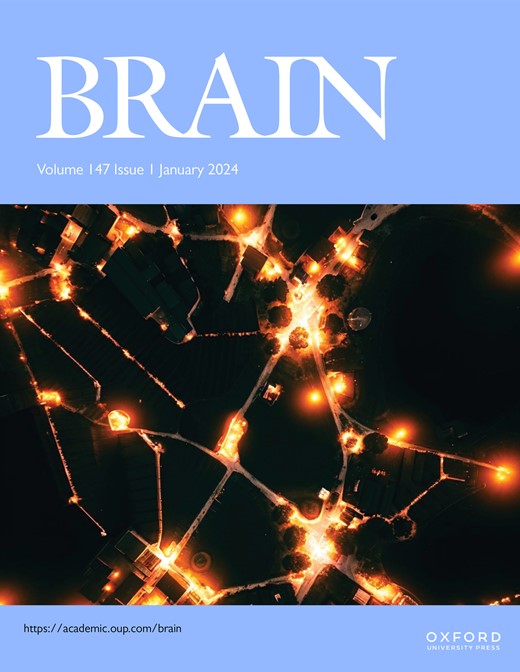α -突触核蛋白种子扩增试验在路易体病谱系中的纵向结果
IF 10.6
1区 医学
Q1 CLINICAL NEUROLOGY
引用次数: 0
摘要
来自神经病理学队列的证据表明,脑脊液α-突触核蛋白(α-syn)种子扩增试验(SAA)可提供与路易体病(LBD)患者α-syn病理负担相关的定量动力学参数。需要进行研究以评估其在症状前和临床疾病阶段的纵向趋势及其与疾病进展测量的相关性。我们的目的是在一组纵向重复采样的路易体病患者中评估α-syn CSF SAA动力学基线参数、它们的纵向变化以及与临床结果的关联,其中包括临床无症状(无症状LBD)和神经功能受损的个体。对前瞻性 BioFINDER-1 研究中纵向采集 CSF 的参与者(n=718)进行了 α-syn SAA 筛查。脑脊液样本在临床诊断盲法下进行了四次重复检测。对所有参与者的基线(首次 SAA 阳性时间)和至少有两个 α-syn 阳性 CSF 样本的参与者的纵向分析。共纳入了 196 名显示出 α-syn 播种活动的参与者(整个队列)。其中,170 人在所有可用样本中的 SAA 检测结果均为阳性,26 人在随访过程中检测结果由阴性转为阳性(枸杞多糖转换者),这表明枸杞多糖处于早期阶段。在基线时,枸杞多糖转化者的 Nrep 值(p=0.001)比在第一个可用样本中显示出 α-syn 播种活动的受试者低,滞后期(p=0.001)比后者长。在整个队列(β=0.09,95% 置信区间 (95%CI) 0.06-0.12,p<0.001)、无症状 LBD(β=0.15,95%CI 0.09-0.21,p<0.001)和无痴呆的帕金森病患者中,Nrep 纵向增加(β=0.07,95%CI 0.02-0.12,p=0.01)。在无症状的枸杞多糖症患者中,滞后值纵向下降(β=-0.24,95%CI -0.42-0.06,p=0.008)。基线 Nrep 可预测整个队列(危险比 (HR) 1.57,95%CI 1.19-2.07,p=0.001)和帕金森病亚组(HR 1.83,95%CI 1.17-2.85,p=0.008)随后出现的痴呆症。在整个队列(HR 0.76,95%CI 0.59-0.99,p=0.04)和帕金森病亚组(HR 0.69,95%CI 0.50-0.95,p=0.02)中,每次采样时的滞后值与基线时的滞后值之间的差异与痴呆症的出现呈负相关。α-syn SAA参数Nrep和Lag显示与LBD阶段和痴呆症的发展有关。此外,它们的纵向变化也与病理学随时间的进展相一致。这些数据支持使用SAA动力学参数来监测疾病进展和治疗反应。本文章由计算机程序翻译,如有差异,请以英文原文为准。
Alpha-synuclein seed amplification assay longitudinal outcomes in Lewy body disease spectrum
Evidence from neuropathological cohorts indicates that a CSF α-synuclein (α-syn) seed amplification assay (SAA) may provide quantitative kinetic parameters correlating with α-syn pathology burden in patients with Lewy body disease (LBD). Studies are needed to assess their longitudinal trend during the pre-symptomatic and clinical disease phases and their correlation with measures of disease progression. We aimed to assess the baseline α-syn CSF SAA kinetic parameters, their longitudinal variations and associations with clinical outcomes in a cohort of longitudinally repeatedly sampled Lewy Body disease patients, including clinically unimpaired (asymptomatic LBD) and neurologically impaired individuals. Participants from the prospective BioFINDER-1 study with longitudinal CSF collections (n=718) were screened by α-syn SAA. CSF samples were tested in four replicates blinded to clinical diagnoses. The number of positive replicates (Nrep), the time needed by the fluorescence signal to reach the threshold (Lag) and the highest intensity of the fluorescent signal (Imax). were analysed at baseline (time of first positive SAA) in all participants and longitudinally in those with at least two α-syn positive CSF samples available. One hundred ninety-six individuals (whole cohort) showing α-syn seeding activity were included. Of those, 170 participants tested positive by SAA in all available samples, while 26 converted from a negative to a positive test result during follow-up (LBD-converters), suggesting an early LBD stage. At baseline, LBD-converters showed lower Nrep (p=0.001) and a longer Lag (p=0.001) than subjects displaying α-syn seeding activity from the first available sample. Nrep increased longitudinally in the whole cohort (β=0.09, 95% confidence interval (95%CI) 0.06-0.12, p<0.001), in asymptomatic LBD (β=0.15, 95%CI 0.09-0.21, p<0.001) and Parkinson’s disease individuals without dementia (β=0.07, 95%CI 0.02-0.12, p=0.01). The Lag decreased longitudinally in asymptomatic LBD (β=-0.24, 95%CI -0.42 - -0.06, p=0.008). Baseline Nrep predicted the subsequent appearance of dementia in the whole cohort (Hazard ratio (HR) 1.57, 95%CI 1.19-2.07, p=0.001) and the Parkinson’s disease subgroup (HR 1.83, 95%CI 1.17-2.85, p=0.008). The difference between the Lag at each sampling and that at baseline was negatively associated with the appearance of dementia in the whole cohort (HR 0.76, 95%CI 0.59–0.99, p=0.04) and Parkinson’s disease subgroup (HR 0.69, 95%CI 0.50-0.95, p=0.02). α-syn SAA parameters Nrep and Lag showed associations with the LBD stage and the development of dementia. Furthermore, their longitudinal variation is coherent with pathology progression over time. These data support the use of SAA kinetic parameters to monitor disease progression and therapeutic response.
求助全文
通过发布文献求助,成功后即可免费获取论文全文。
去求助
来源期刊

Brain
医学-临床神经学
CiteScore
20.30
自引率
4.10%
发文量
458
审稿时长
3-6 weeks
期刊介绍:
Brain, a journal focused on clinical neurology and translational neuroscience, has been publishing landmark papers since 1878. The journal aims to expand its scope by including studies that shed light on disease mechanisms and conducting innovative clinical trials for brain disorders. With a wide range of topics covered, the Editorial Board represents the international readership and diverse coverage of the journal. Accepted articles are promptly posted online, typically within a few weeks of acceptance. As of 2022, Brain holds an impressive impact factor of 14.5, according to the Journal Citation Reports.
 求助内容:
求助内容: 应助结果提醒方式:
应助结果提醒方式:


